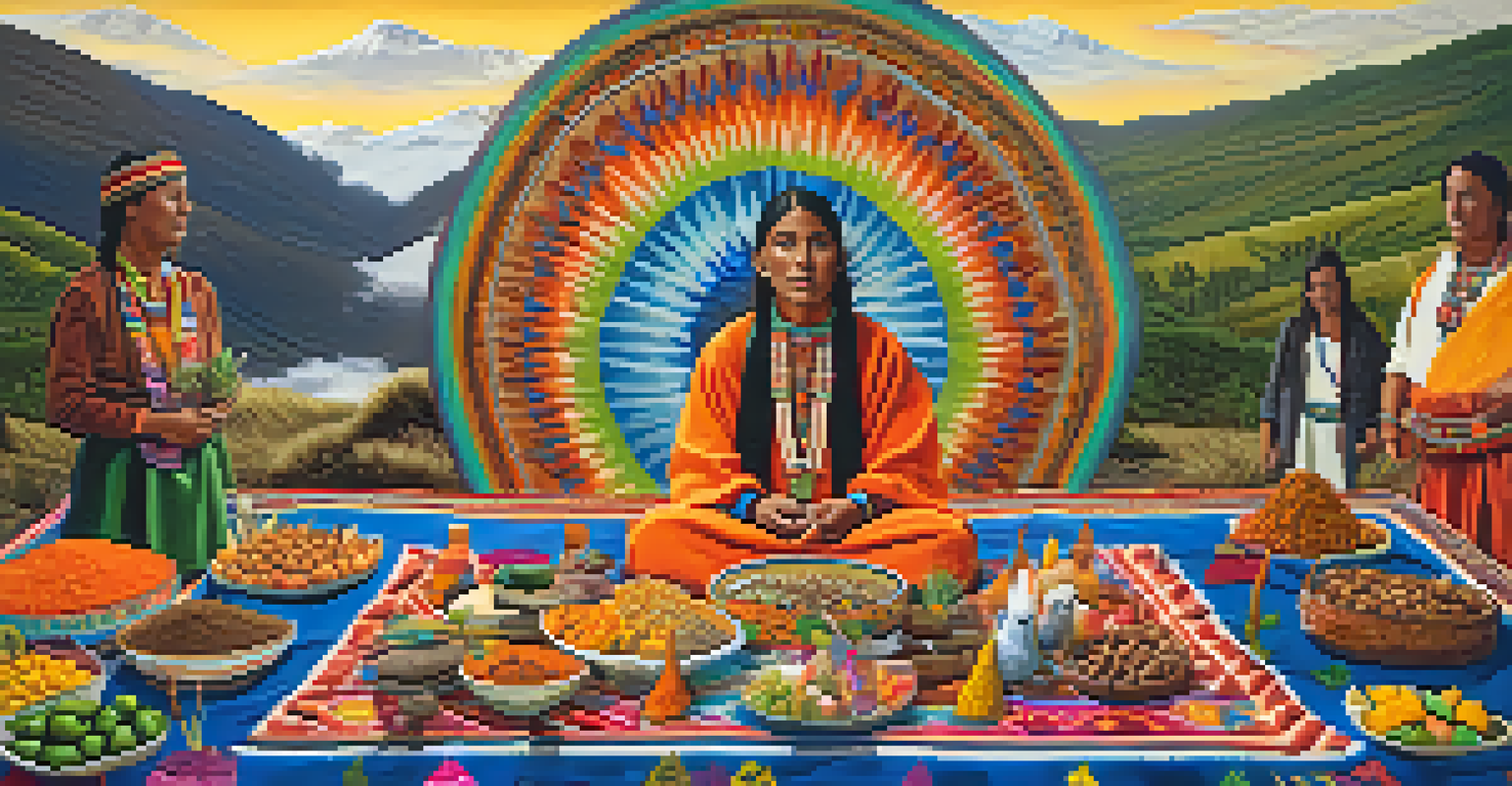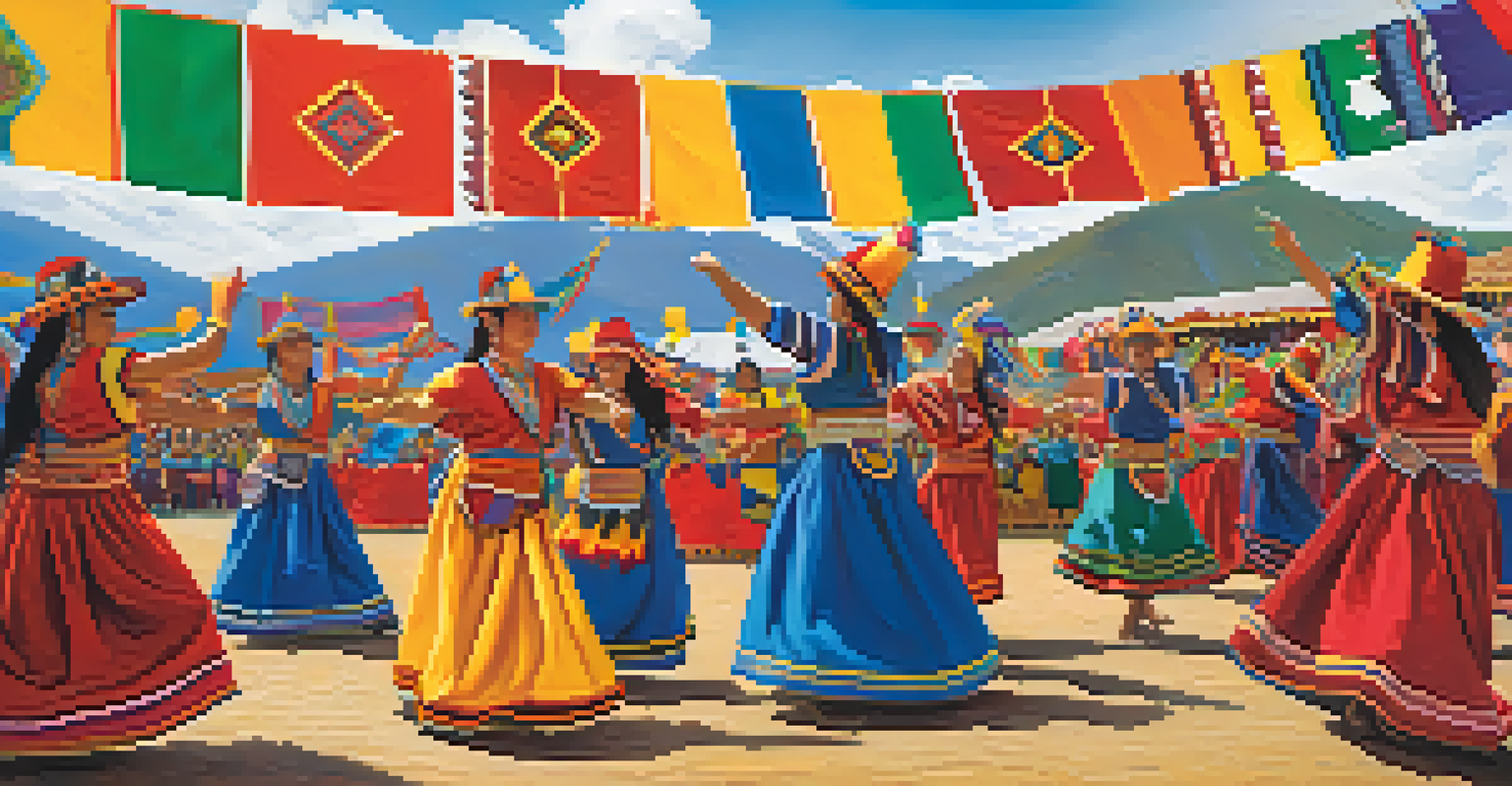The Legend of Pachamama: Earth Mother of the Andes

Introduction to Pachamama: The Earth Mother
Pachamama is revered as the Earth Mother in Andean cultures, embodying fertility, agriculture, and nature's bounty. Her name translates to 'Mother Earth' in the indigenous Quechua language, reflecting her deep-rooted connection to the land. For centuries, communities in the Andes have celebrated her as a vital force in sustaining life, making her an integral part of their cultural identity.
The Earth has music for those who listen.
Legends of Pachamama tell of her nurturing qualities, often depicted as a figure who provides sustenance and protection to those who honor her. Many believe that she has the power to influence the harvest, weather, and overall well-being of the earth. This reverence for Pachamama highlights the importance of living in harmony with nature, a principle that resonates strongly within Andean communities.
As we delve deeper into Pachamama's story, we'll explore her origins, rituals, and the vital role she plays in the spiritual lives of the Andean people. Understanding Pachamama is not just about mythology; it’s about grasping the profound relationship between humanity and nature.
The Origins of Pachamama's Legend
The legend of Pachamama dates back to pre-Incan civilizations, where she was worshiped as a deity of fertility and the harvest. Ancient cultures believed she created the earth, mountains, and crops, making her a central figure in their cosmology. These early stories often emphasized her duality, portraying her as both a nurturing mother and a powerful force of nature.

As the Inca Empire rose, Pachamama's significance expanded further, intertwining with religious practices and social customs. The Incas viewed her as a protector of the land, instilling a sense of responsibility among their people to honor and care for the earth. This cultural reverence ensured that Pachamama remained a prominent figure even as civilizations evolved.
Pachamama's Role in Andean Culture
Pachamama is celebrated as the Earth Mother, symbolizing fertility and the nurturing aspects of nature within Andean traditions.
Through the centuries, the tales of Pachamama have been passed down orally, evolving with each generation while maintaining core themes of respect for the environment. This oral tradition has kept her legend alive, allowing the essence of Pachamama to thrive amid modern challenges.
Pachamama in Andean Cosmology
In Andean cosmology, Pachamama is often depicted alongside Inti, the Sun God, showcasing the balance between earth and sky. Together, they represent the duality of existence, where Pachamama nurtures life while Inti provides warmth and light. This interplay emphasizes the interconnectedness of all living things, a concept deeply ingrained in Andean spirituality.
We do not inherit the earth from our ancestors, we borrow it from our children.
Pachamama is also associated with cycles of life, death, and rebirth, symbolizing the agricultural calendar. Her fertility is believed to be essential for successful crops, and rituals are often performed to ensure her blessings. These practices reflect a profound understanding of the environment, teaching communities to respect the land and its resources.
Furthermore, Pachamama's presence is felt in various aspects of daily life, from farming techniques to social gatherings. Her influence serves as a reminder of the importance of living in harmony with nature, an idea that resonates even in today's world.
Rituals and Offerings to Pachamama
Rituals honoring Pachamama are deeply embedded in Andean culture, with ceremonies often held during planting and harvesting seasons. These events typically involve offerings, known as 'despachos,' which may include food, flowers, or even llama fat. Such offerings symbolize gratitude and respect, ensuring that Pachamama is acknowledged for her gifts.
One popular ritual is the 'Pachamama Raymi,' a festival celebrated in August, where communities come together to express their appreciation for the earth. Participants engage in traditional dances, music, and communal feasting, creating a vibrant atmosphere of joy and gratitude. This celebration strengthens community bonds and reinforces the importance of Pachamama in their lives.
Rituals of Gratitude and Respect
Communities perform various rituals and offerings to Pachamama, especially during planting and harvesting seasons, to express gratitude for her blessings.
Additionally, individuals often perform smaller, personal rituals, such as burying offerings in the ground or placing them at sacred sites. These acts of devotion serve as a reminder of the sacredness of the earth and the reciprocal relationship between humanity and nature.
Pachamama's Influence on Modern Culture
Despite the passage of time, Pachamama's influence continues to resonate in contemporary Andean society. Many modern movements advocate for environmental protection and sustainability, drawing inspiration from her teachings. This revival of indigenous wisdom highlights the relevance of Pachamama in addressing current global challenges, such as climate change.
In addition, Pachamama has become a symbol of resistance for many indigenous communities, representing their connection to the land and their fight for rights. Her image is often used in protests against mining, deforestation, and other practices that threaten the environment. This modern interpretation of Pachamama underscores the enduring power of her legend.
Moreover, Pachamama's significance has extended beyond the Andes, inspiring artists, writers, and activists worldwide. Her story encourages a greater appreciation for nature and serves as a call to action for environmental stewardship, reminding us all of our shared responsibility to protect the earth.
Pachamama in Popular Media
Pachamama's legend has found its way into popular media, sparking interest in her story across various platforms. Films, documentaries, and books have explored her significance, helping to educate a broader audience about Andean culture and spirituality. This representation not only honors Pachamama but also showcases the richness of indigenous heritage.
One notable example is the animated film 'The Emperor's New Groove,' which features elements inspired by Andean mythology, including references to Pachamama. While the portrayal may be lighthearted, it introduces viewers to the cultural richness of the Andes, encouraging curiosity and appreciation for these traditions.
Pachamama's Modern Relevance
Pachamama's teachings continue to inspire environmental movements and cultural expressions worldwide, emphasizing the importance of sustainability and respect for the earth.
Additionally, social media platforms have become a space for sharing stories and artwork related to Pachamama. This digital representation allows for a global dialogue about her importance, fostering a sense of community among those who resonate with her message of environmental respect and stewardship.
Conclusion: The Lasting Legacy of Pachamama
The legend of Pachamama serves as a powerful reminder of our connection to the earth and the importance of nurturing that relationship. Her teachings about respect, gratitude, and harmony with nature are more relevant today than ever. As we face environmental challenges, embracing Pachamama's wisdom can guide us toward sustainable practices and a deeper appreciation for the planet.
Pachamama's legacy is not confined to the Andes; it has inspired movements and individuals around the world to advocate for environmental justice. By honoring her story, we are also honoring the countless generations that have cherished and protected the earth. This connection helps bridge cultural divides, fostering a global community dedicated to preserving our environment.

Ultimately, Pachamama is more than just a figure in mythology; she represents the spirit of the earth itself. As we reflect on her legacy, let us strive to embody her values in our daily lives, ensuring that we leave a thriving planet for future generations.